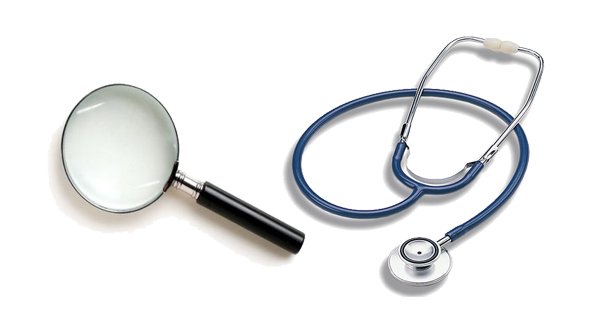In this week’s case, Dr. Detective meets an apparently healthy woman whose unexplained stomachaches have left a series of doctors scratching their heads – but whose problems are solved with a simple elimination diet.
Eat less and exercise more. It’s generally a great prescription for improving health and improving body composition. However, it doesn’t always work.
Even with an awesome exercise plan and a rock-solid diet, some people suffer from mysterious symptoms and complaints that seem puzzling, given how much effort they put into their fitness and health.
When we meet clients who have problems that exercise and nutrition – not to mention their own doctors – can’t seem to solve, we know there are only a few experts on the planet to turn to. One of them is Spencer Nadolsky.
Dr. Nadolsky is a doctor of osteopathic medicine who’s also studied exercise physiology and nutrition. An academic All-American wrestler in university, he’s still an avid exerciser and brilliant physician who practices what he preaches to patients – treating preventable diseases first with lifestyle modifications (instead of prescription drugs).
When clients have nowhere else to turn, Dr. Nadolsky turns from a cheerful, sporty doctor into a meticulous, take-no-prisoners forensic physiologist. He pulls out his microscope, analyzes blood, saliva, urine, lifestyle – whatever he has to, in order to solve the medical mystery.
When Dr. Nadolsky volunteered to work on a regular case study feature with us, we jumped at the chance. By following along with these fascinating cases, you’ll see exactly how a talented practitioner thinks. You’ll also learn how to improve your own health.
In today’s case, we meet a young woman who was feeling more than a little irritable about her diagnosis of Irritable Bowel Syndrome – and we’ll review the simple brilliance of the elimination diet.

The client
Linda, a 33 year-old woman, sought me out via an online integrative medicine database for her stomach aches.
This was Linda’s first visit to me, but she had already seen at least eight other doctors for the same problem. And by now, she was fed up. One by one, those other doctors had diagnosed her stomachaches as irritable bowel syndrome, or IBS. One by one, they’d given her this label and sent her on her way – with no solutions.
Linda didn’t want a name for her problem. She wanted somebody to fix it.
The pressure was on.
The client’s signs and symptoms
Linda looked extremely healthy compared to many of my patients. At 5′ 2” she weighed 115 pounds. She was in good shape. Her vital signs were all normal.
Pleasant and soft-spoken, she told me that her stomachaches had been bothering her for about a year.
You know what real estate agents say: Location, location, location. Well, a good diagnostician says: History, history, history. The history holds the clues – and more often than you’d expect, in describing the problem the patient will reveal the diagnosis.
So I asked Linda to tell me everything she knew about her bellyaches. When did they come on? What did they feel like?
Linda described a burning in the lower part of her abdomen, as well as a rumbling sensation. These symptoms had started off quite mild – maybe two out of ten on a one-to-ten scale – but over the course of the year they’d become considerably worse, now registering about seven out of ten. They came and went, sometimes together and sometimes alone. She thought they might be related to food, but she wasn’t entirely sure.
Naturally, when the problems had first came up, she’d gone to see her primary care physician. Unsure what to make of her symptoms, he’d sent her to a gastroenterologist, who’d ordered a colonoscopy. No answers there, either.
Next stop? Gynecology. Since Linda’s pain was in her lower abdomen, it made sense to order a transvaginal ultrasound, just to make sure that the problem wasn’t in her uterus or pelvic area.
But her pelvic exams came back normal.
And by now, Linda was frustrated. She’d been offered proton pump inhibitors, Tylenol, and even narcotics – but she still didn’t have an answer.
| Signs / Symptoms | My thoughts – potential issues | |
|---|---|---|
|
Could be many things including gastrointestinal and also gynecological |
So far, I wasn’t doing a whole lot better than the other doctors. And I needed to step things up, because with these symptoms, there are a few diseases you don’t want to overlook.
We discussed Linda’s eating habits. She had tried switching to a Paleo diet. Had it helped? She wasn’t sure. It was tough to stick to the diet – especially without any confidence that it was right for her.
Recently, she’d begun to take probiotics and she was also exercising more. But once again, she found it difficult to say whether she’d seen improvements since making these changes. Her symptoms seemed to come and go, regardless.
Irritable Bowel Syndrome
Irritable bowel syndrome was the name the other doctors had given to Linda’s distress.
IBS is diagnosed when a person has suffered from abdominal pain or discomfort at least three times per month for a three-month period – and there is no underlying disease or injury that could cause the pain.
In other words, IBS is what’s known as a “functional” gastrointestinal disorder, meaning that people who suffer from it have symptoms, but the GI tract does not become damaged.
In the past, IBS was known by a whole lot of other names, including colitis, spastic colon, spastic bowel, and even “nervous” colon. That’s because – not finding any underlying disease – doctors were inclined to think that the pain was all in the patient’s imagination.
Nowadays, most doctors recognize that the pain is very real. But they still don’t understand what causes it.
Meanwhile, if a patient also experiences weight loss, rectal bleeding or blood in the stool, or has a family history of colon cancer, celiac disease, or inflammatory bowel disease (such as Crohn’s or ulcerative colitis) these are red flags for underlying problems. When any of these signs are present, it’s important to order an extensive workup, including an endoscopy with possible biopsy (among other tests).
Additional clues
Luckily, nobody in Linda’s family suffered from the red flag diseases. But she did say that she’d lost about 10 pounds without intending to – and recently, she’d seen some blood in her stools. Not only that, but these symptoms had arisen after her visit to the GI doctor, so he hadn’t known about them when he’d performed her tests.
Hmmm. This was cause for concern. I decided to send her for another scope to rule out celiac disease and inflammatory bowel disease.
But before sending her on her way, I performed a thorough physical – which was normal – and sent her for some blood work, hoping that would give me a few clues.
The tests and assessments
Blood chemistry panel
Along with markers for inflammation and celiac disease, I ordered some blood chemistry tests.
| Marker | Result | Lab Reference Range | Thoughts |
|---|---|---|---|
| Fasting glucose | 82 mg/dL | 65-99 | No signs of insulin/glucose issues |
| AST | 16 IU/L | <35 | No signs of liver inflammation/damage |
| ALT | 13 IU/L | 10-35 | No signs of liver inflammation/damage |
| Albumin | 4.5 | 3.5-5 g/dl | Good liver function |
| Alkaline phosphatase | 53 IU/L | 44-147 | No signs of biliary obstruction |
| Calcium | 9.1 mg/dL | 8.7-10.2 | No hypercalcemia |
| White blood cell count | 8.0 x10^3/µL | 4.0-10.5 | No signs of immune dysfunction |
| Hemoglobin | 12.3 g/dL | 11.1-15.9 | No signs of anemia |
| Erythrocyte sedimentation rate | 2 mm/hr | 0-31 | No signs of inflammation |
| C-reactive protein | 3.4 mg/L | 0-4.9 | On the higher end of normal. This is another inflammatory marker. But it is not alarming. |
Nothing here jumped out at me.
Linda’s celiac markers were also negative. But recall that she had been avoiding wheat. In situations like that, celiac markers may not show up. I filed that information for future reference, and sent her on her way to the gastroenterologist.
One month later
Linda brought me the results of both the upper and lower endoscopy. The good news was that she definitely did not show any signs of inflammatory bowel disease.
Nor was there any blunting of the intestinal villi – which is a specific sign of celiac disease.
However, the GI doctor did note some non-specific changes in the small intestine called intraepithelial lymphocytosis (lymphocytes in the GI lining).
His diagnosis? You guessed it: irritable bowel syndrome.
By now, I was scratching my head in confusion along with all the other docs. Because these days, we consider intraepithelial lymphocytosis to be at the beginning of the spectrum of celiac disease!
So which was Linda’s problem, really? IBS… or incipient celiac disease?
Either way, there was only one method to determine what was bothering her. It was high time Linda began an elimination diet.
Offering her a handout outlining the protocol, I explained why she needed to adhere to it. But I wasn’t really very worried. I knew Linda would follow directions because she was highly motivated to learn the cause of her problems.
Linda’s third visit
One month later, Linda walked into my office smiling. It was obvious that she was feeling a whole lot better. And no wonder. Together, we had cracked the case and cured her problems.
Her carefully compiled food log revealed that her symptoms arose from none other than the usual suspects. That’s right. Linda was sensitive to the nefarious triumvirate of wheat, dairy, and coffee.
The twist? Each food gave rise to a different symptom. The coffee caused the burning and the wheat and dairy caused rumbling.
Aha! No wonder her symptoms had been confusing. There was more than one cause.
Linda now understood that she needed to avoid these foods.
We also discussed the possibility that she had the beginnings of celiac disease or perhaps gluten sensitivity, and I suggested that she should probably keep gluten out of her diet completely. Linda was more than willing to go along with the prescription.
The bonus? On the day of Linda’s visit, I happened to have a medical student shadowing me. She got to witness the effectiveness of an elimination diet first-hand. With a bit of luck, this will translate to her future practice.
The prescription
An elimination diet
So simple – but not always so easy. Doctors hesitate to recommend elimination diets, probably in part because so few patients will comply. But any good detective knows that simple elimination can help us deduce the cause. And typically, the answers are not long in coming.
Avoid the culprits
It’s elementary! Once you find the sources that cause digestive issues, stop eating them. Of course, it’s also best to ensure that there are no other underlying causes.
The outcome
Linda was ecstatic that we solved her digestive problems without giving her narcotics or proton pump inhibitors. These days, she continues to eat a gluten-free diet with the occasional dairy or coffee treat. Her problems have disappeared.
Summary and recommendations
What can we take away from Linda’s story?
- If you have bellyaches with blood in the stool and/or weight loss, see your doctor. These symptoms can indicate serious underlying problems.
- An elimination diet might help identify food sensitivities.
- Covering up your symptoms with a drug isn’t always necessary – and it may not be advisable.
Learn more
Want to get in the best shape of your life, and stay that way for good? Check out the following 5-day body transformation courses.
The best part? They're totally free.
To check out the free courses, just click one of the links below.




Share